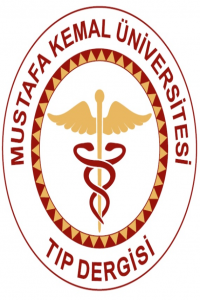Abstract
Aim: Plastic handcuffs are usually used in mass arrest incidents by law enforcement agencies. Using them are increased due to its being lighter, cheaper, more hygienic, and easier to carry and apply. In this study, we aimed to discuss the problems occurred during the use of plastic handcuffs and problems with the medico-legal documents prepared before and after police custody. Material and Method: In our study, 70 students who were taken in custody and plastic handcuffed during social events at university were evaluated. Results: Medical examinations after police custody reveal that skin lesions in accordance with handcuffing were seen in 35,7 percent of all cases and knife-cut injuries during the uncuffing were seen in 2,9 percent of all cases. In 50 percent of the cases (n: 20), however, there were skin lesions that were not documented in the examination performed in the hospital before police custody. Results: If plastic handcuffs must be used during the police arrest, they should not be too tight and during uncuffing, equipment which decreases the risk of injury had better be used. Also medical examination report should be arranged in a way to accelerate the justice process, and prevent the loss of right. Therefore health personnel should be well educated for a complete overall medical examination
References
- Çiçekli B, Eryılmaz MB, Yılmaz Ö. Avrupa İnsan Hakları Mahkemesi Türkiye Kararlarının Analizi. Uluslararası Hukuk ve Politika 2007; 3(9): 28-59.
- http://www.resmigazete.gov.tr/eskiler/2005/06/20050601-10.htm. Erişim Tarihi: 02.02.2015.
- Kantarcı MN, Kandemir E, Berber G, Baştürk M, Fincancı ŞK. Gözaltı muayenelerinde plastik ve metal kelepçeye bağlı yaralanmaların değerlendirilmesi. Türkiye Klinikleri J Med Sci 2013; 33(2) :360-65.
- Grant AC, Cook AA. A prospective study of handcuff neuropathies. Muscle Nerve 2000; 23(6): 933-38.
- Stone DA, Laureno R. Handcuff neuropathies. Neurology 1991; 41(1): 145-47.
- Vorbrüggen M, Baer HU. Humiliation: the lasting effect of torture. Mil Med 2007; 172(12): 29-33.
- Vetter S. Understanding human behavior in times of war. Mil Med 2007; 172(12): 7-10.
- Singh S, Dahal K, Mills E. Nepal's war on human rights: a summit higher than Everest. Int J Equity Health 2005; 4:9.
- http://www.ttb.org.tr/eweb/istanbul_prot/ist_protokolu.html. Erişim Tarihi: 12.08.2015.
- Keten A, Akçan R, Karacaoğlu E, Odabasi AB, Tümer AR. Medical forensic examination of detained immigrants: is the Istanbul Protocol followed? Med Sci Law 2013; 53(1): 40-44.
- Yeşil O, Öztürk TC, Çevik ŞE, Güneysel Ö. İdari Amaçlı Muayeneler: Acil Olmayan Aciller. Sakarya Medical Journal 2011; 4: 130-34.
- Ünüvar Ü, Can İÖ, Fincancı ŞK, Bakkalcı M, Tellioğlu A, Özdemir B, et al. İstanbul protokolü eğitimleri öncesi Türkiye genelinden gözaltı giriş ve çıkış raporlarının değerlendirilmesi. Adli Tıp Bülteni 2014; 19(3):154-60.
Abstract
Amaç: Plastik kelepçeler, toplu gözaltı uygulamalarında, genellikle güvenlik güçleri tarafından kullanılmaktadır. Hafif, kolay taşınır, ucuz, hijyenik ve uygulamasının kolay olması gibi nedenlerden dolayı kullanımı giderek artmaktadır. Bu çalışmada plastik kelepçe uygulamasında ortaya çıkan sorunların tartışılması ve gözaltı giriş çıkış raporlarının incelenmesi amaçlanmıştır.
Gereç ve Yöntem: Çalışmamızda, üniversitede meydana gelen olaylarda gözaltına alınan ve plastik kelepçe takılan 70 öğrenci değerlendirmeye alındı.
Bulgular: Gözaltı çıkış muayenesinde olguların % 35,7‘sinde kelepçe ile uyumlu cilt lezyonları ve % 2,9’unda plastik kelepçenin çıkartılması esnasında bıçak kullanımı ile oluşmuş cilt kesileri tespit edildi. Vücudunda travmatik lezyon olmasına rağmen %50 (n:20) olguda mevcut olan lezyonların hastanede yapılan gözaltı giriş muayenesinde kayıt edilmediği görüldü.
Sonuç: Gözaltı uygulamalarında plastik kelepçe kullanma zorunluluğu varsa çok sıkı olmamalı ve kelepçelerin çıkarılması esnasında yaralanma riskini en aza indiren aletler kullanılmalıdır. Ayrıca gözaltı muayene raporları eksiksiz, adli süreci hızlandırıcı ve hak kayıplarının önüne geçecek şekilde düzenlenmelidir. Bunun için de adli muayeneyi yapacak olan sağlık personelinin eğitilmesi gerekmektedir.
Anahtar kelimeler: Plastik kelepçe, gözaltı muayenesi, adli tıp
Keywords
References
- Çiçekli B, Eryılmaz MB, Yılmaz Ö. Avrupa İnsan Hakları Mahkemesi Türkiye Kararlarının Analizi. Uluslararası Hukuk ve Politika 2007; 3(9): 28-59.
- http://www.resmigazete.gov.tr/eskiler/2005/06/20050601-10.htm. Erişim Tarihi: 02.02.2015.
- Kantarcı MN, Kandemir E, Berber G, Baştürk M, Fincancı ŞK. Gözaltı muayenelerinde plastik ve metal kelepçeye bağlı yaralanmaların değerlendirilmesi. Türkiye Klinikleri J Med Sci 2013; 33(2) :360-65.
- Grant AC, Cook AA. A prospective study of handcuff neuropathies. Muscle Nerve 2000; 23(6): 933-38.
- Stone DA, Laureno R. Handcuff neuropathies. Neurology 1991; 41(1): 145-47.
- Vorbrüggen M, Baer HU. Humiliation: the lasting effect of torture. Mil Med 2007; 172(12): 29-33.
- Vetter S. Understanding human behavior in times of war. Mil Med 2007; 172(12): 7-10.
- Singh S, Dahal K, Mills E. Nepal's war on human rights: a summit higher than Everest. Int J Equity Health 2005; 4:9.
- http://www.ttb.org.tr/eweb/istanbul_prot/ist_protokolu.html. Erişim Tarihi: 12.08.2015.
- Keten A, Akçan R, Karacaoğlu E, Odabasi AB, Tümer AR. Medical forensic examination of detained immigrants: is the Istanbul Protocol followed? Med Sci Law 2013; 53(1): 40-44.
- Yeşil O, Öztürk TC, Çevik ŞE, Güneysel Ö. İdari Amaçlı Muayeneler: Acil Olmayan Aciller. Sakarya Medical Journal 2011; 4: 130-34.
- Ünüvar Ü, Can İÖ, Fincancı ŞK, Bakkalcı M, Tellioğlu A, Özdemir B, et al. İstanbul protokolü eğitimleri öncesi Türkiye genelinden gözaltı giriş ve çıkış raporlarının değerlendirilmesi. Adli Tıp Bülteni 2014; 19(3):154-60.
Details
| Primary Language | Turkish |
|---|---|
| Journal Section | Original Articles |
| Authors | |
| Publication Date | September 30, 2015 |
| Submission Date | May 14, 2015 |
| Published in Issue | Year 2015 Volume: 6 Issue: 23 |


